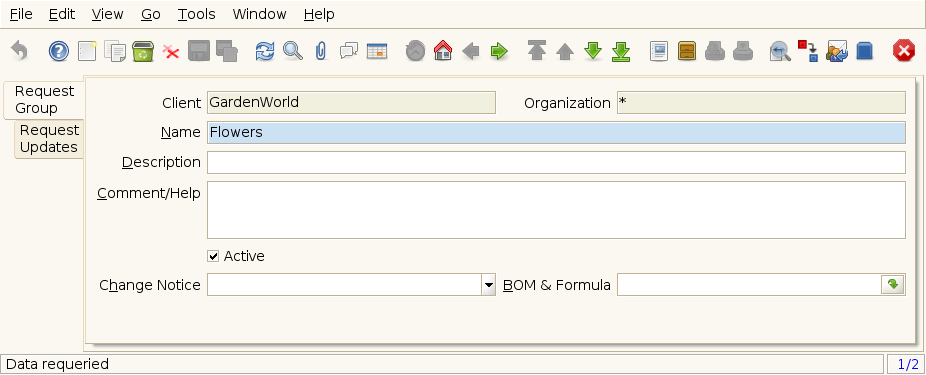Request Group (Window ID-346)
Window: Request Group
Description: Maintain Request Group
Help: Group of requests (e.g. version numbers, responsibility, ...)
Tab: Request Group
Description: Maintain Request Groups
Help: Group of requests (e.g. version numbers, responsibility, ...). If a BOM is referenced and enabled in Request Type, a BOM Change Request is automatically created.
| Name | Description | Help | Technical Data |
|---|---|---|---|
| Tenant | Tenant for this installation. | A Tenant is a company or a legal entity. You cannot share data between Tenants. | R_Group.AD_Client_ID numeric(10) Table Direct |
| Organization | Organizational entity within tenant | An organization is a unit of your tenant or legal entity - examples are store, department. You can share data between organizations. | R_Group.AD_Org_ID numeric(10) Table Direct |
| Name | Alphanumeric identifier of the entity | The name of an entity (record) is used as an default search option in addition to the search key. The name is up to 60 characters in length. | R_Group.Name character varying(60) String |
| Description | Optional short description of the record | A description is limited to 255 characters. | R_Group.Description character varying(255) String |
| Comment/Help | Comment or Hint | The Help field contains a hint, comment or help about the use of this item. | R_Group.Help character varying(2000) Text |
| Active | The record is active in the system | There are two methods of making records unavailable in the system: One is to delete the record, the other is to de-activate the record. A de-activated record is not available for selection, but available for reports.
There are two reasons for de-activating and not deleting records: (1) The system requires the record for audit purposes. (2) The record is referenced by other records. E.g., you cannot delete a Business Partner, if there are invoices for this partner record existing. You de-activate the Business Partner and prevent that this record is used for future entries. |
R_Group.IsActive character(1) Yes-No |
| BOM & Formula | BOM & Formula | R_Group.PP_Product_BOM_ID numeric(10) Search |
Tab: Request Updates
Description: List Recipients for to receive Request Updates
Help:
| Name | Description | Help | Technical Data |
|---|---|---|---|
| Tenant | Tenant for this installation. | A Tenant is a company or a legal entity. You cannot share data between Tenants. | R_GroupUpdates.AD_Client_ID numeric(10) Table Direct |
| Organization | Organizational entity within tenant | An organization is a unit of your tenant or legal entity - examples are store, department. You can share data between organizations. | R_GroupUpdates.AD_Org_ID numeric(10) Table Direct |
| Group | Request Group | Group of requests (e.g. version numbers, responsibility, ...) | R_GroupUpdates.R_Group_ID numeric(10) Table Direct |
| User/Contact | User within the system - Internal or Business Partner Contact | The User identifies a unique user in the system. This could be an internal user or a business partner contact | R_GroupUpdates.AD_User_ID numeric(10) Search |
| Active | The record is active in the system | There are two methods of making records unavailable in the system: One is to delete the record, the other is to de-activate the record. A de-activated record is not available for selection, but available for reports.
There are two reasons for de-activating and not deleting records: (1) The system requires the record for audit purposes. (2) The record is referenced by other records. E.g., you cannot delete a Business Partner, if there are invoices for this partner record existing. You de-activate the Business Partner and prevent that this record is used for future entries. |
R_GroupUpdates.IsActive character(1) Yes-No |
| Self-Service | This is a Self-Service entry or this entry can be changed via Self-Service | Self-Service allows users to enter data or update their data. The flag indicates, that this record was entered or created via Self-Service or that the user can change it via the Self-Service functionality. | R_GroupUpdates.IsSelfService character(1) Yes-No |


